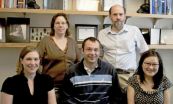(Press-News.org) This press release is available in German.
Methane is formed under the absence of oxygen by natural biological and physical processes, e.g. in the sea floor. It is a much more powerful greenhouse gas than carbon dioxide. Thanks to the activity of microorganisms this gas is inactivated before it reaches the atmosphere and unfolds its harmful effects on Earth's climate. Researchers from Bremen have now proven that these microorganisms are quite picky about their diet.
All life on Earth is based on carbon and its compounds. Cell components of all creatures contain carbon. The cell can take up this basic structural element via organic matter or builds up its own organic matter from scratch, i.e. carbon dioxide. Researchers termed the first type of cells heterotrophs and the latter autotrophs. All plants, many bacteria and archaea are autotrophs, whereas all animals, including humans, are heterotrophs. The autotrophs form the basis for the life of the heterotrophs and all higher life by taking up inorganic carbon to form organic material.
To keep the cellular systems running all cells need fuel. Methane can be such a fuel. When studying the methane consuming microbes discovered by Bremen scientists more than ten years ago, it was assumed that they take the methane for filling up their energy tanks and use it as a carbon source, i.e., they were thought to be heterotrophs.
Now scientists from MARUM and the Max Planck Institute for Marine Microbiology have shown that this is surprisingly not the case: the methane derived carbon is not used as a carbon source. "Our growth studies clearly show that the labelled carbon in the methane never showed up in the cell material, but experiments with labelled carbon from carbon dioxide did. It was quite surprising," says author Matthias Kellermann. The archaea in the consortia behave as expected for chemoautotrophs. "Archaea and the sulphate reducing bacteria are living closely together in consortia, which grow extremely slowly. And it was only in the newly synthesised cell materia that we could find the answer for the question from where the carbon originates," adds Kai-Uwe Hinrichs, leader of the organic geochemistry group at MARUM.
Co-author Gunter Wegener from the Max Planck Institute concludes: "With our new knowledge we can optimise our studies about the inactivation of methane in nature. Our surprising results tell us that we still know very few details of this globally important process."
Samples were retrieved from the Guaymas Basin on the West coast of Mexico from a depth of more the 2000 metres using the US diving submersible Alvin.
INFORMATION:
Original study:
Matthias Y. Kellermann, Gunter Wegener, Marcus Elvert, Marcos Yukio Yoshinaga, Yu-Shih Lin,
Thomas Holler, Xavier Prieto Mollar, Katrin Knittel, and Kai-Uwe Hinrichs
Autotrophy as a predominant mode of carbon fixation in anaerobic methane-oxidizing microbial communities
PNAS doi/10.1073/pnas.1208795109
Strange diet for methane consuming microorganisms
Methane supplies the energy for cell metabolism, but is not the carbon source
2012-11-06
ELSE PRESS RELEASES FROM THIS DATE:
Early treatment sparks striking brain changes in autism
2012-11-06
When given early treatment, children with autism spectrum disorders (ASD) made significant improvements in behavior, communication, and most strikingly, brain function, Yale School of Medicine researchers report in a new study.
The study was published in the current issue of the Journal of Autism and Developmental Disorders by Yale Child Study Center researchers Fred Volkmar, M.D., Kevin A. Pelphrey, and their colleagues.
The results suggest that brain systems supporting social perception respond well to an early intervention behavioral program called pivotal response ...
HF patients treated by a cardiologist, rather than hospitalist, have fewer readmissions
2012-11-06
MINNEAPOLIS, MN – November 6, 2012 – When a cardiologist attends to heart failure patients, even when the severity of illness is higher, patients have reduced rates of hospital readmissions, compared with those patients who are treated by a hospitalist, according to a trial being presented today at the American Heart Association's scientific sessions in Los Angeles.
Congestive heart failure (CHF) is the most common cause for hospital readmission in patients over the age of 65 years. Whereas efforts to reduce readmission rates have focused on transitions of care and short-term ...
Living abroad can bring success -- If you do it right
2012-11-06
"Travel broadens the mind" goes the old adage, and potential employers often agree, valuing the open-mindedness and creativity fostered by such worldliness. But according to new Tel Aviv University research, not all international experiences are created equal.
"Although living abroad does help to hone creative abilities, not all individuals who have lived abroad derive an equal benefit from such experiences," explains Dr. Carmit Tadmor of TAU's Recanati School of Business, who conducted the study with Dr. Adam Galinsky of the Kellogg School of Management at Northwestern ...
Team finds a new way to inhibit blood clotting and inflammation
2012-11-06
CHAMPAIGN, lll. — Scientists have identified a group of small molecules that interfere with the activity of a compound that initiates multiple steps in blood clotting, including those that lead to the obstruction of veins or arteries, a condition called thrombosis. Blocking the activity of this compound, polyphosphate, could treat thrombosis with fewer bleeding side effects than the drugs that are currently on the market.
Their findings appear in the journal Blood.
Blood clots are formed at the site of an injured blood vessel to prevent blood loss. Sometimes, however, ...
New study reveals challenge facing designers of future computer chips
2012-11-06
To build the computer chips of the future, designers will need to understand how an electrical charge behaves when it is confined to metal wires only a few atom-widths in diameter.
Now, a team of physicists at McGill University, in collaboration with researchers at General Motors R&D, have shown that electrical current may be drastically reduced when wires from two dissimilar metals meet. The surprisingly sharp reduction in current reveals a significant challenge that could shape material choices and device design in the emerging field of nanoelectronics.
The size of ...
ICDs can reduce sudden death in young patients with hypertrophic cardiomyopathy
2012-11-06
MINNEAPOLIS, MN – November 5, 2012 – A multicenter registry has demonstrated that the use of implantable cardioverter-defibrillators (ICDs) to combat sudden cardiac death in high-risk pediatric patients suffering from hypertrophic cardiomyopathy (HCM). The study is being presented Nov. 5 at the 2012 Scientific Sessions of the American Heart Association (AHA) in Los Angeles.
While the study found that the rate of possible device complications adds a level of complexity to this age group, it also demonstrated that life-saving ICD interventions were common in younger patients ...
Higher anxiety associated with poorer functioning in children with 22q11.2 deletion syndrome
2012-11-06
UC Davis researchers have found that for children with the genetic disorder known as chromosome 22q11.2 deletion syndrome anxiety -- but not intelligence -- is linked to poorer adaptive behaviors, such as self-care and communication skills, that affect daily life. The developmental syndrome, which is associated with a constellation of physical, cognitive and psychiatric problems, usually is apparent at birth or early childhood, and leads to lifelong challenges.
The study findings suggest that helping children cope with fear-based symptoms may be the best strategy for ...
Overweight patients hospitalized with pneumonia more apt to survive
2012-11-06
Medical researchers at the University of Alberta studied the records of nearly 1000 patients who were admitted to hospital with pneumonia and noted those who were obese were more apt to survive compared to those who were of normal weight.
For their research study, the team examined the records of 907 patients with pneumonia who were admitted to six Edmonton hospitals and also had their body mass index recorded. Two-thirds of the patients had severe pneumonia and 79 died in hospital. Of those who died, 12 were under weight, 36 were normal weight, 21 were overweight and ...
Older adults who are frail much more likely to be food insufficient, according to national study
2012-11-06
CORVALLIS, Ore. – A national study of older Americans shows those who have limited mobility and low physical activity – scientifically categorized as "frail" – are five times more likely to report that they often don't have enough to eat, defined as "food insufficiency," than older adults who were not frail.
The nationally representative study of more than 4,700 adults older than age 60 in the United States uses data from the Third National Health and Nutrition Examination Survey. The results are online today in the British Journal of Nutrition.
Lead author Ellen Smit, ...
Daily multivitamin use does not reduce cardiovascular disease risk in men
2012-11-06
Boston, Mass. – Approximately one-third of Americans take a daily multivitamin, but little is known about a multivitamin's long-term affect on chronic diseases. Now, new research from Brigham and Women's Hospital (BWH) finds that daily multivitamin use does not reduce the risk of cardiovascular disease in men. A similar BWH study, announced last month, found daily multivitamin use can reduce a man's risk of cancer by 8 percent. The cardiovascular disease findings will be presented Nov. 5 at the American Heart Association's Scientific Sessions 2012 and published simultaneously ...
LAST 30 PRESS RELEASES:
This new understanding of T cell receptors may improve cancer immunotherapies
A new fossil face sheds light on early migrations of ancient human ancestor
A new immunotherapy approach could work for many types of cancer
A new way to diagnose deadly lung infections and save lives
40 percent of MRI signals do not correspond to actual brain activity
How brain-inspired algorithms could drive down AI energy costs
Gum disease may be linked to plaque buildup in arteries, higher risk of major CVD events
Contrails are a major driver of aviation’s climate impact
Structure of dopamine-releasing neurons relates to the type of circuits they form for smell-processing
Reducing social isolation protects the brain in later life
Keeping the heart healthy increases longevity even after cancer
Young adults commonly mix cannabis with nicotine and tobacco
Comprehensive review illuminates tau protein's dual nature in brain health, disease, and emerging psychiatric connections
Book prepares K-12 leaders for the next public health crisis
Storms in the Southern Ocean mitigates global warming
Seals on the move: Research reveals key data for offshore development and international ecology
Sports injuries sustained during your period might be more severe
World's first successful 2 Tbit/s free-space optical communication using small optical terminals mountable on satellites and HAPS
Can intimate relationships affect your heart? New study says ‘yes’
Scalable and healable gradient textiles for multi‑scenario radiative cooling via bicomponent blow spinning
Research shows informed traders never let a good climate crisis go to waste
Intelligent XGBoost framework enhances asphalt pavement skid resistance assessment
Dual-function biomaterials for postoperative osteosarcoma: Tumor suppression and bone regeneration
New framework reveals where transport emissions concentrate in Singapore
NTP-enhanced lattice oxygen activation in Ce-Co catalysts for low-temperature soot combustion
Synergistic interface engineering in Cu-Zn-Ce catalysts for efficient CO2 hydrogenation to methanol
COVID-19 leaves a lasting mark on the human brain
Scientists use ultrasound to soften and treat cancer tumors without damaging healthy tissue
Community swimming program for Black youth boosts skills, sense of belonging, study finds
Specific depressive symptoms in midlife linked to increased dementia risk
[Press-News.org] Strange diet for methane consuming microorganismsMethane supplies the energy for cell metabolism, but is not the carbon source


